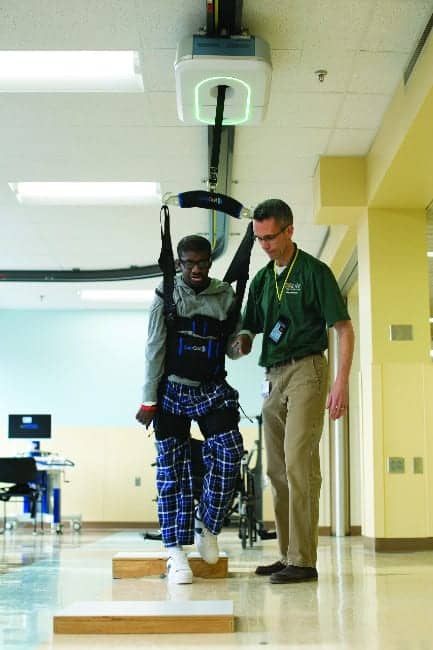(Pictured above) When individuals are harnessed in the SafeGait 360, they are able to perform higher-level balance activities. Patients are encouraged to complete them without upper-extremity support to help them improve their tolerance to daily activities and decrease their overall fall risk.
By Ashley DiCostanzo, PT, DPT
Individuals who have experienced a cerebrovascular accident (CVA) arrive to physical therapy with a wide range of functional abilities. It is imperative for physical therapists to thoroughly assess functional limitations present as a result of CVA, as well as collaborate with patients and their families in creating achievable and functional goals. Depending on the extent of impairments, it is common for these patients to participate in outpatient physical therapy for an extended period of time. Experiencing a functional plateau within this period is a possibility, but it is crucial for therapist and patient to work through this to determine whether functional gains remain possible, or if maximum benefit has been achieved and transition to independent management is warranted.
Defining “Plateau”
It is important to question what constitutes a plateau. This term is loosely defined and likely determined on a case-by-case basis. Simplistically stated, a functional plateau occurs when a patient no longer is making significant changes in the area being addressed in skilled services. For example, if dynamic balance is the primary focus of treatment, an outcome measure such as the mini best test may be used to objectively measure the aforementioned balance. If a patient does not improve by a minimum of four points, a clinically significant change has not been achieved.1 If a patient continues to have difficulty with these interventions within therapy sessions, is expressing concerns regarding balance not changing, and/or the standardized outcome measurements indicate lack of clinically significant difference, it is likely the patient has plateaued.
The next question will likely address what is to be done if a functional plateau occurs. If a true plateau has occurred, it is best to transition to independent management. Like most areas of practice in physical therapy, this will look different for each patient. This may mean discharging the patient with a thorough home exercise program that can be completed independently or with caregiver assistance. This can also be a patient participating in an independent gym program with appropriate progressions at a private gym, home gym, or overseen by a rehab aide at a designated facility. Another discharge option is to educate patient and caregiver(s) about progression of functional activities and increasing duration and intensity of daily tasks to continue to facilitate improved independence and best prevent a functional decline after discharge. It is important to note, if plateau is assumed to be caused by the presence of underlying conditions, it is expected that education will be provided to patients and/or caregiver(s) to follow up with appropriate providers.
[sidebar float=”right” width=”250″]Product Resources
The following companies provide technologies that can be useful in the treatment of stroke and neurological conditions:
Allard USA Inc
www.allardusa.com
Biodex
www.biodex.com
Bioness
www.bioness.com
CIR Systems/GAITRite
www.gaitrite.com
Gorbel Rehabilitation
www.safegait.com
Hocoma
www.hocoma.com
Mobility Research
www.litegait.com
ProtoKinetics
www.protokinetics.com
Saebo Inc
www.saebo.com
Solo-Step
www.solostep.com
Tekscan
www.tekscan.com
Vista Medical
www.boditrak.com[/sidebar]
Preventing Plateaus
As physical therapists, it is best to consider what can be done clinically to prevent a functional plateau from occurring. One important treatment parameter to evaluate is exercise intensity. Current research indicates patients status post CVA should be exercising at 70-80% of their heart rate reserve.2 Although an exact measurement of exertion may be difficult to obtain in a standard physical therapy clinic, it is a good reminder to utilize exertional scales, monitor vitals, and encourage therapists to appropriately facilitate higher levels of patient effort.
To ensure that progress toward desired goals are being achieved, re-assessment of goals is beneficial in guiding future treatment sessions. The content required for documentation can seem tedious at times. However, the goals that are created are intended to guide the current treatment plan. Re-assessment of these goals—determined by treating therapists—aids in determining whether goals are patient-specific, functional, and realistic. The goal patients most commonly present to physical therapy after a CVA is to return to walking. The details of this goal are imperative to elaborate on since there are many ways in which the goal may be reached.
Walking can be achieved with or without an assistive device, for short distances or community lengths, can require the use of adaptive equipment such as an ankle foot orthosis (AFO), or presume the return of functional activation in the involved lower extremity. Setting of goals and evaluating progress toward these goals with patient and/or caregiver(s) is one of the best ways to prevent a functional plateau as it keeps treatment functional and specific to each patient’s needs.
As is true with most patients, treatment after a CVA does not follow a specific formula. It is important to determine when an updated evaluation should be completed to decide whether significant changes are occurring to best achieve the aforementioned goals. Utilization of a wide variety of outcome tools can also be useful in assessing a patient’s functional abilities as well as their confidence with daily activities. An example of a useful subjective outcome tool is the ABC scale.3 This questionnaire can be interpreted in two loose categories: first is to assess for a patient’s increasing confidence with functional mobility; second is to identify a patient’s increasing fear of independent mobility. Either result is important to address in therapy. It is also important to evaluate whether patient confidence coincides with functional abilities that have been demonstrated during physical therapy sessions. At times it is useful to incorporate the family and caregiver(s) into this aspect of care as they witness the carryover and implementation of these interventions into daily mobility.
Technology Boosts Patient Confidence
Utilization of all available resources is another key to success. Each facility offers unique treatment options, whether it be therapists with specialized training and/or availability of specialized equipment. An example of this type of equipment is present at F.F. Thompson Hospital in Canandaigua, NY. The SafeGait 360, created by Gorbel Rehabilitation, Victor, NY, is “an overhead dynamic body weight support and fall protection system.”4 Whether a patient is evaluated specifically for the use of the SafeGait 360 by a referring physician or the treating therapist determines a patient would be appropriate upon evaluation, it is a widely used resource with overall good patient satisfaction. The device allows patients to explore their functional abilities without the risk or fear of falling.
The SafeGait 360 is a body support system that safely secures patients in a specialized harness and connects to an overhead actuator. This unit allows for normal movements to occur with up to 50% reduction of a patient’s body weight. While in the SafeGait 360, patients are able to perform gait training with or without the use of an assistive device, perform higher-level balance interventions with or without upper-extremity support (this assists with training independent postural reactions), endurance training on or off the treadmill, floor-to-stand transfers, and more. By using this device, patients are able to demonstrate functional abilities as well as address areas of continued weakness or concerns and assist with increasing the patient’s overall confidence in independent completion of daily tasks. The device can also be utilized to assess safety with patient-specific activities in which the patient and/or caregiver are fearful of the patient completing independently.
The use of specialized equipment such as the SafeGait 360 can assist with facilitating a higher level of exertion from a patient. Patients may be less inclined to participate in interventions targeting endurance training with the least restrictive assistive device if their fear of falling is greater than their desire to walk with less assistance. This technology can also be useful when trialing advanced dynamic balance interventions since its design prevents patients from falling and hurting themselves.

Technology Options
Several other types of overhead body weight support technologies designed for clinical use are available. Among those options is the Vector from Valencia, Calif-based Bioness. The Vector uses an overhead trolley and suspends the patient using a harness. The system is designed to provide overground training activities that include stair climbing, balance exercise, and treadmill endurance training. The LiteGait from Mobility Research, Tempe, Ariz, is another solution that provides body weight support for gait therapy. This device uses a harness, straps, and Y-shaped yoke, and has a wheeled base that permits overground walking. Another device, the Andago from Hocoma, Norwell, Mass, also provides overhead body weight support for self-directed gait and is designed to bridge the gap between treadmill-based gait training and untethered overground walking.
Team Up
Aside from specialized equipment or training, one of the best resources available to therapists is the clinical team of which they are a part. All team members in the direct team, such as physical therapists and/or physical therapy assistants, offer unique insight as to appropriate interventions to utilize as well as the availability of alternative treatments. When treating a patient for an extended period of time, it is common to become distracted on specific task training and lose sight of the full potential of a patient’s movement abilities. Utilizing all team members can assist with a holistic treatment approach and once again avoid risk for functional plateau.
Typically, it is in the best interest of the patient for therapists to use a multi-disciplinary approach. It is important to remember the vast impact a CVA can have on all areas of function in the human body. Discussing patient cases with other therapists, such as occupational therapists and speech therapists, allows for knowledge to be shared and collaborated on to achieve optimal outcomes. It is also of use to discuss clinical findings, areas of concern, or the desired future plan of care with referring physicians in order to present a uniform plan of care. Recovery after a CVA can be complicated and filled with multiple follow-up appointments from varying providers. It is beneficial to the patient when all providers are educating them about the premise of a unified plan of care.
Resources for Recovery
Treatment of patients who have experienced a CVA is complicated. It is best to utilize a multi-disciplinary approach with as many professionals involved in patient care as possible: Collaborate with team members, listen to new perspectives, try something new. Do all that can be done to avoid a functional plateau and provide the patient the opportunity to achieve optimal recovery after a CVA. Be sure to use all the resources available and be creative in intervention application. Remember that what is being provided to patients is a guideline for the start of their new way of life. Patient safety, satisfaction, and optimal return of functional recovery is the desired outcome. The interventions and way in which that is achieved will be unique to every patient. PTP
Ashley DiCostanzo, PT, DPT, attended Upstate Medical University and began working at FF Thompson upon graduation in 2011. She primarily treats patients affected by neurological conditions. DiCostanzo recently obtained her LSVT certification, has attended McKenzie part A, and received extensive hands-on experience treating the lumbar spine. For more information, contact [email protected].
References
1. Mini Balance Evaluation System Test. Available at: https://www.sralab.org/rehabilitation-measures/mini-balance-evaluation-systems-test. Published June 4, 2013. Accessed December 12, 2019.
2. Hornby TG, Holleran CL, Hennessy PW, et al. Variable intensive early walking poststroke (VIEWS): a randomized controlled trial. Neurorehabil Neural Repair. 2016;30(5):440-450.
3. Activities-Specific Balance Confidence Scale. Available at: https://www.sralab.org/rehabilitation-measures/activities-specific-balance-confidence-scale. Published March 22, 2013. Accessed December 12, 2019.
4. Gorbel Rehabilitation. https://www.gorbelrehabilitation.com. Accessed December 13, 2019.





